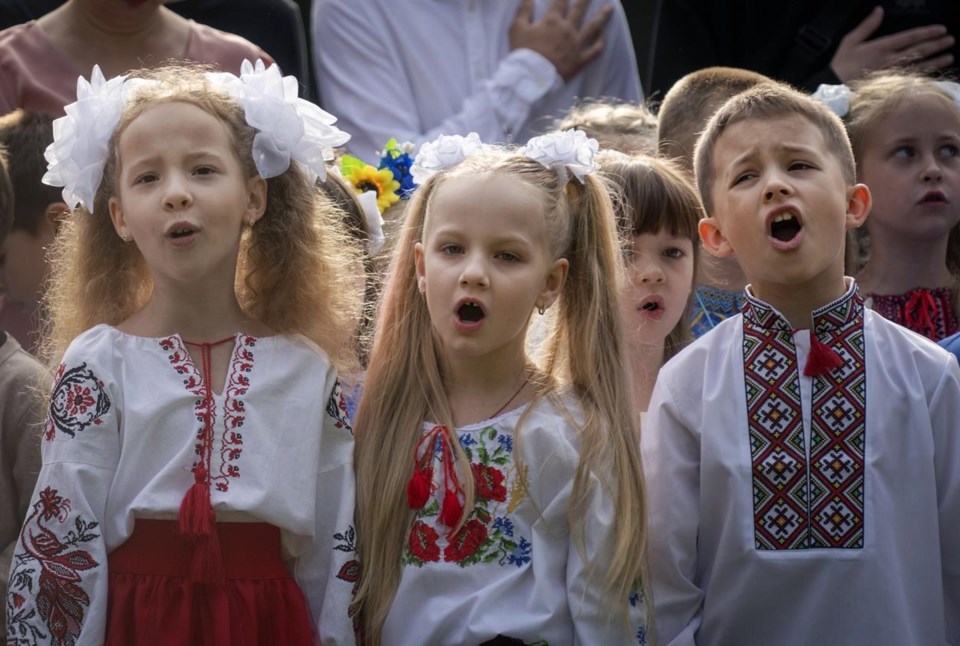BUCHA, Ukraine (AP) — In a small courtyard at a school in Bucha, scene of some of the worst atrocities committed by Russian soldiers during the war, Ukrainian children gathered Friday to celebrate the first day of the new school year.
First graders dressed in Ukrainian embroidered costume shirts known as vyshyvankas, with neat hairstyles and holding bouquets of flowers, line up hesitantly along an improvised stage. Parents, many struggling to contain their emotions, smile and wave from the crowd, constantly taking photos.
But the festive ambiance quickly shifts as the Ukrainian national anthem is played, followed by a solemn minute of silence in memory of fallen Ukrainian soldiers. Onstage, the children stand quietly, and in the audience, some parents quietly wipe away tears.
“We are not afraid of war or missiles, because we will overcome everything!” a final year student shouts from the stage.
This atmosphere of joy mixed with sorrow sets the tone for the start of the new school year in Ukraine.
Despite many schools being renovated, the educational process here in this is far from normal. Due to constant missile threats and air raid sirens, students are compelled to learn partially in bomb shelters and remotely.
Many schools in Ukraine lack the capacity to provide a safe space for all students, leading them to implement a hybrid learning model. Under this approach, students alternate between learning at school one week and at home the next. This allows children to take turns so that each of them has the opportunity to attend in-person classes for at least two weeks per month.
Schools that offer in-person lessons, even in a hybrid model, have their own shelter or shelters nearby that could be used.
Continued attacks on education inside Ukraine and low-level enrolment in host countries have left many of Ukraine’s 6.7 million 3- to 18-year-olds struggling to learn, said UNICEF's regional director for Europe and Central Asia, Regina De Dominicis.
According to UNICEF, in Ukraine, children are experiencing widespread learning loss in the Ukrainian language, reading, and mathematics due to the combined impact of the COVID-19 pandemic and the war, resulting in a fourth year of disrupted education.
At the school in Bucha, in the suburbs of Kyiv, only first graders and those in their senior year and their parents attended Friday’s back to school celebration, to minimize crowds.
“We are beginning the second year under wartime conditions,” school director Mykhailo Nakonechnyi said, addressing the children during the ceremony.
The school underwent repairs to the roof, which was damaged by shrapnel during the early stages of the war when Bucha was occupied. Graphic evidence of killings and torture emerged following the withdrawal of Russian forces in the spring of 2022.
Once the Russians had gone, life in this school, which now educates over 1,700 students, gradually began to recover. The educational institution has welcomed approximately 200 internally displaced children from Kharkiv, Kherson, Luhansk, and Donetsk regions that are close to the front line.
Nakonechnyi says he is apprehensive that Russians might attack the energy infrastructure of Ukraine the same way they did last winter.
“And under these conditions, we are not prepared to teach,” he said, explaining that the school lacks an adequate number of generators to ensure its autonomy during blackouts.
“Learning in shifts is more manageable, but it’s not real learning,” said Anna Chornobai, 16, a senior year student.
She described the war as a “catastrophe” that has altered her present and future plans. Before the Russian invasion, she had plans to study design in Kyiv. Now she finds challenging to focus and struggles to finish a single drawing.
“Now I have only one option - to go abroad and study there because here there is war and air raid sirens,” she said.
Nakonechnyi also mentioned approximately 500 students from his school who fled the war to countries abroad.
“We are waiting for them,” he spoke loudly, but with a hint of sadness.
Hanna Arhirova, The Associated Press




